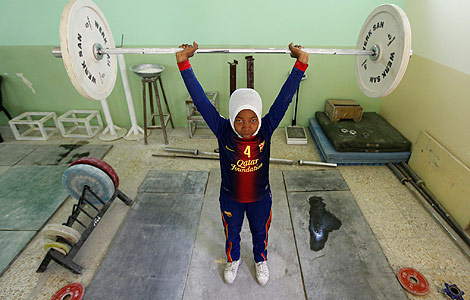Sculpting the souls
Updated: 2013-05-01 00:15
By Xie Chuanjiao (China Daily)
|
|||||||||||
His most cherished work is the group sculptures for the Nanjing Massacre Memorial Hall, which were completed in 2007.
The artist said he felt a responsibility to reflect the calamity caused on the Chinese people by the Japanese invasion and to convey the values of peace and dignity.
One of the group sculptures is "The Last Drop of Milk". It depicts the true story told by Chang Zhiping, a massacre survivor who witnessed his baby brother taking the last milk from the breast of his dying mother. Another piece called "The Monk" depicts a monk with his eyes closed praying for the souls of those killed.
Born into a family of calligraphers, Wu developed an interest in the arts during his childhood. It was not until he began to study at Wuxi Municipal Institute of Arts and Crafts in Jiangsu province that he formally started his sculpting career.
"Although the school was small and unknown at the time, I was lucky enough to learn at the highest level from several of the best folk artists in China," Wu said, adding he was grateful to his alma mater.
"The folk arts are full of the wisdom of Chinese people, which inspired the creativity in my sculpture."
In the mid-1990s, Wu got the opportunity to further study art in several European countries and the United States. His experiences abroad helped enormously in developing his craft.
"My career really took off after I returned from abroad," he said.
Wu once saw a sculpture created by a 100-year-old man in Spain. He immediately recognized it was Christopher Columbus discovering the new continent now known as North America even though he was too far away to clearly see his countenance. It was the dynamic outline that made it so distinctive, he said.
He eventually developed a new style of "freehand and expressive sculpture" by putting more emphasis on the "essence" of sculpted figures than their facial appearances.
"Sculptures should be made between resemblance and expression," said Wu, who was wearing a jacket displaying Chinese traditional decoration.
Related Stories
Bird-like sculpture hits Guagnzhou 2013-04-28 14:25
Bronze sculptures continue to shine 2013-04-02 07:50
Sculpture exhibition held in Qingdao 2013-03-28 16:27
Exhibition of clay sculpture art held at UNESCO Centre of Macao 2013-03-08 14:33
Today's Top News
Mental health law to take effect
Chinese visitors to Thailand grow 93 pct
Reform and opening up reshapes Chinese labor
City unites to say farewell
Willem-Alexander succeeds mother
Alibaba pays $586 million for stake in Sina Weibo
Three buried after lab explosion
EU to ban pesticides blamed for harming bees
Hot Topics
Lunar probe , China growth forecasts, Emission rules get tougher, China seen through 'colored lens', International board,
Editor's Picks

|

|

|

|

|

|





